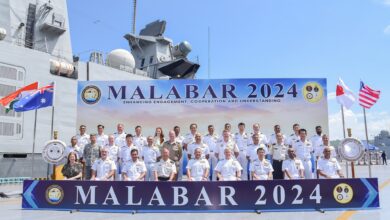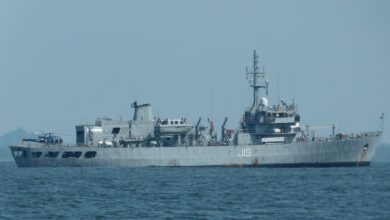India Boosts Maritime Muscle In Arabian Sea, Strengthens Naval Force

- The pirates had already left by the time the special commando force got on board for so-called "sanitization" operations
- There was also hope that Beijing had "taken note" of India's quick action, which made the pirates "run away like rats."
Analysts say the dramatic drone video of Indian commandos hunting pirates after an attack in the Arabian Sea shows the “significant” growth of New Delhi’s strong maritime force, which shows its global goals.
The soldiers were sent out this month from an Indian-built warship after an attempt to take over a merchant bulk carrier. They are part of a large increase in naval forces in the seas where China has been expanding its reach for a long time.
The head of the Society for Policy Studies think tank in New Delhi, Uday Bhaskar, said, “It’s important given the geopolitical context” and the aggressive “use of naval assets.”
In the past few years, as part of its Belt and Road Initiative, Beijing has made deals with Sri Lanka, the Maldives, Bangladesh, and Djibouti to build infrastructure. In 2017, China opened its first military base outside of China, which made Indian officials nervous.
Now, Prime Minister Narendra Modi, who is likely to be re-elected later this year, wants to make India, which has the world’s fifth-largest economy and became the most populous country last year, more powerful on the world stage.
“As India continues to rise in the ladder of great powers around the world, it wants to show itself as a leading and responsible power,” said Don McLain Gill of the Philippines’ De La Salle University.
Gill told AFP that part of its “desire to play a larger and more proactive role as a responsible security and development partner” is to send ships to the area.
Very proactive action
Indian troops have been fighting pirates for a long time.
Since 2008, when piracy increased, the military has been stationed off of Somalia all the time. They have been bombarding and sinking pirate “motherships” from the coast of India to the Gulf of Aden, getting on boats by helicopter and arresting dozens of gunmen.
But in December, the navy sent out a much bigger force with three guided-missile destroyers and P-8I reconnaissance planes to “maintain a deterrent presence” in response to a string of attacks on ships. This is a rapid buildup of troops.
Defense Minister Rajnath Singh promised that ships would be safe “from the sea to the heights of the sky” when he spoke at the launch of India’s newest warship, which will join an existing fleet of aircraft carriers and submarines that were all built in India.
The reaction came after a drone attack on the MV Chem Pluto tanker on December 23 about 200 nautical miles (370 km) off the coast of India. Washington said the attack was done by Iran, but Tehran called the claims “worthless.”
The Houthis in Yemen, who are backed by Iran, have attacked many Israeli-linked ships in the Red Sea in response to Israel’s war against Hamas, a Palestinian terrorist group that is also backed by Tehran.
Indian trades with Iran, but it hasn’t joined the US-led group fighting the Huthis.
Thursday, US President Joe Biden said that US and British forces had attacked Huthi targets in Yemen by air. He called it a “defensive action” in response to the recent attacks on ships in the Red Sea.
In a statement, the US and nine allies said that their goal was to “protect the free flow of commerce” in the important shipping lanes and make them more stable.
But because international naval troops were sent north into the Red Sea, New Delhi is still worried about how this will affect trade. This is because pirates may try to take advantage of the gap in the defenses, as the first successful case of Somali piracy since 2017 was recorded in December.
A study from the Research and Information System for Developing Countries in New Delhi said India could lose $30 billion in exports this year, which is a drop of 6%. This is because more ships would have to go through South Africa instead of India.
Admiral Hari Kumar, India’s chief of naval forces, told reporters on Wednesday that the country was “very proactive” in making sure pirates “don’t venture out into the India Ocean region.” He said this while showing off an Indian-made long-range reconnaissance drone.
Run away like rats
According to the Indian navy, an Indian destroyer and surveillance aircraft followed the Liberian-flagged MV Lila Norfolk on January 5 and gave it a “forceful warning” after it reported an attempted hijacking about 450 nautical miles off the coast of Somalia.
The pirates had already left by the time the special commando force got on board for so-called “sanitization” operations, but the navy showed off the video as proof of their “swift response” skills.
An ex-navy officer named Bhaskar said it showed that India “can mount a credible naval presence in the Indian Ocean region when required at short notice.”
Beijing and New Delhi are both trying to gain power across the Indian Ocean. India has sent troops to the disputed South China Sea and Western Pacific in the past.
China, a rival Asian power, has been more “cautious in its response given its worry of not upsetting its recently developing ties with the Arab world,” Gill said. At the same time, India has also sent more troops into the Arabian Sea.
DK Sharma, a former navy spokeswoman, said the deployment was only meant to stop “miscreants taking advantage of the Israel-Hamas war” by attacking ships.
“India believes in maintaining peace in the global commons,” said Sharma. “We have no ambitions to say that the Indian Ocean is India’s ocean.”
There was also hope that Beijing had “taken note” of India’s quick action, which made the pirates “run away like rats.”
He said, “China can see it any way they want.”







Facebook Comments